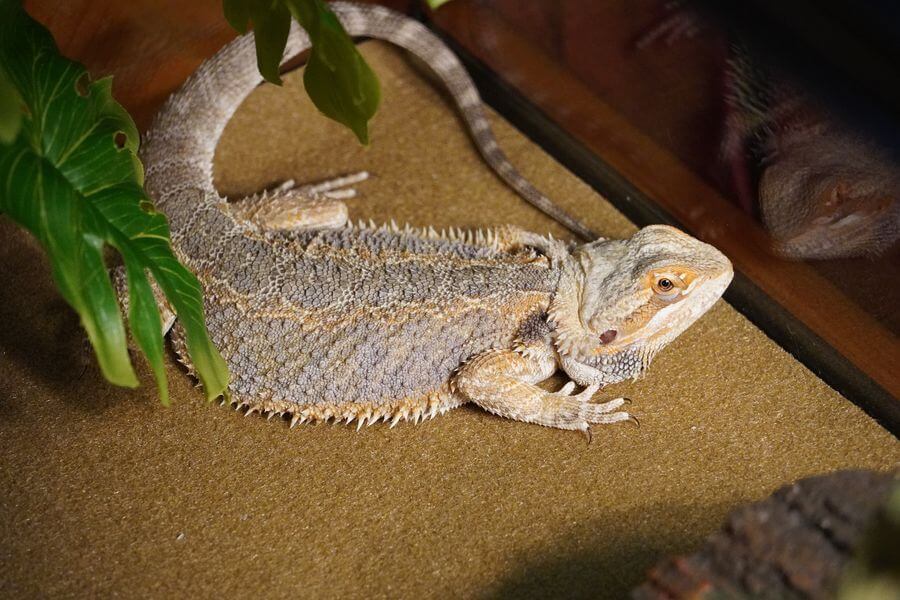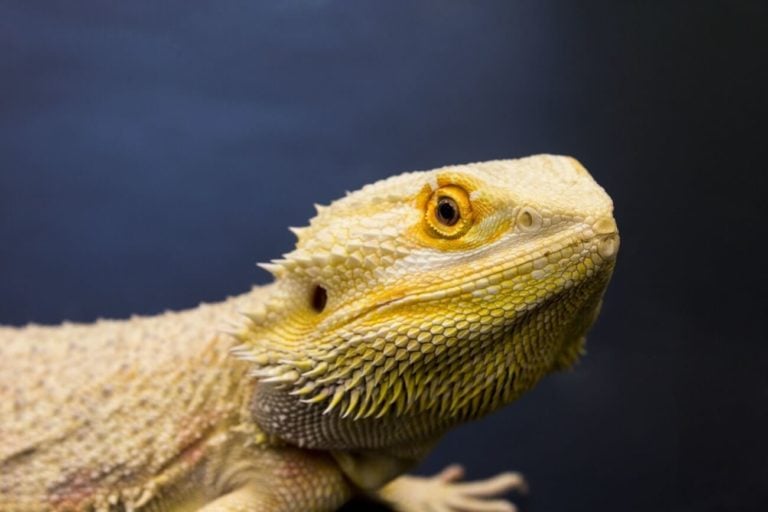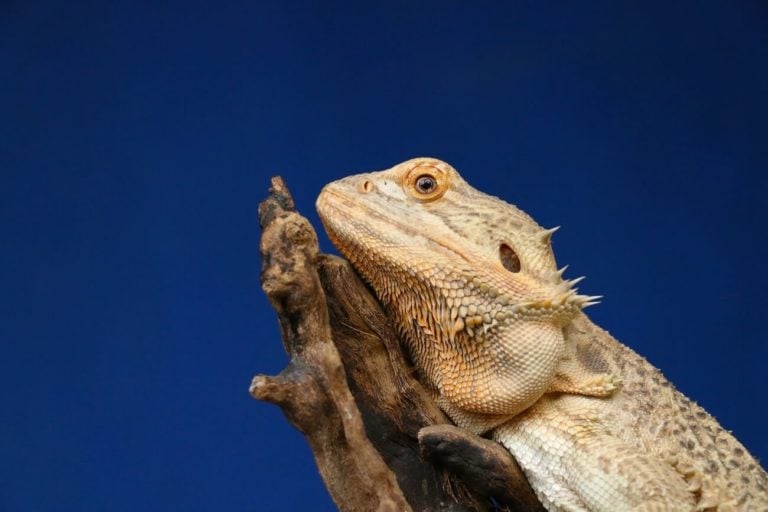Are you curious to know why your bearded dragon decides to lay flat at times? In the realm of herpetology, this behavior is commonly referred to as “pancaking”. It’s a unique feature of their overall body language that can often leave their owners puzzled. Understanding why your beardie adopts this flattened posture can help you better cater to its needs and ensure it stays healthy.
This article aims to explore some key reasons behind such behaviors and guide you in understanding your pet’s actions and health a bit better.
Table of Contents
What Is Bearded Dragon “Pancaking: Or Laying Flat?
When your bearded dragon “pancakes” or lays flat, it’s exactly what it sounds like. Imagine them puffing up and spreading out like a pancake on the griddle!
By laying flat, they make themselves seem bigger by expanding their bellies outward and stiffening their side spikes. Even though they might look stuck in this position, rest assured that they can still move around, albeit at a slower pace.
When a bearded dragon is laying flat, many newer owners become worried that something is wrong. But that’s not always the case! It’s all about knowing how to identify this behavior so you can determine the cause.
Why Bearded Dragons Lay Flat
A bearded dragon that lays flat could indicate a number of different things. While these reptiles sometimes do this for no apparent reason, there are other instances when it’s actually a sign that you need to do something.
Here are the main causes to be aware of so you can take action if needed.
1. They Need To Warm Up
If your scaly friend pancakes often, it could be a sign that they’re trying to soak up some extra warmth. Bearded dragons are exothermic creatures, which means they rely on their environment for heat regulation. Laying flat or “pancaking” is one of the natural behaviors they use to achieve this. By flattening their bodies, more of their skin surface is exposed to UV rays and external heat sources.
This behavior is especially crucial after meals as bearded dragons require an increase in body temperature for efficient digestion. However, if you observe your bearded dragon pancaking continuously with a darkened beard even 48 hours post-meal, it might be a signal that the tank temperature isn’t adequate enough for them. Proper basking temperatures typically fall between 107 and 113 degrees Fahrenheit.
Any deviation from this temperature range may lead to stress for your bearded dragon and potentially cause health issues like sluggishness or even gut rot due to poor digestion. Always keep an eye out on these signs and regulate the tank’s temperature accordingly to maintain optimal health conditions for your lizard.
2. Scared Or Defensive Behavior
Your scaly companion’s pancaking behavior isn’t always about staying cozy; sometimes, it’s their way of expressing fear or defensiveness. It’s a natural reaction in bearded dragons when confronted with potential threats, akin to a survival tactic from their wild counterparts. When threatened, your beardie might lay flat making themselves appear larger and more formidable to scare off predators. This defensive strategy isn’t limited to those in the wild; domesticated bearded dragons may also exhibit this behavior if they feel stressed or scared.
Household pets like dogs or cats can intimidate your bearded dragon, triggering this defensive response. Even you as an owner can cause such a reaction if your pet perceives you as a threat. That’s why it’s crucial for you to build trust gradually through careful handling and feeding routines.
New objects in their habitat can also cause anxiety due to unfamiliarity and result in them spending more time laying flat. Additionally, ensuring that their habitat is away from windows and high-traffic areas aids in reducing perceived threats like moving cars or birds outside which might set off this fear-induced flattening behavior.
If your little reptilian friend continues exhibiting stress after an acclimation period with the new items, it might be a good idea to remove them from the tank and put them back in an environment where they feel comfortable.
3. Sickness
Spotting your bearded dragon laying flat can sometimes signal more than just fear or discomfort; it could be a red flag for underlying health issues. Pancaking can be a response to pain from digestive complications like impaction, constipation, or diarrhea.
If you notice your bearded dragon refusing food and laying flat with a lowered head, they might be dehydrated. In such cases, immediate rehydration becomes essential and may even require veterinary fluid therapy.
Additionally, if your beardie tends to close its eyes while pancaking, this could indicate a parasitic infection that necessitates an urgent vet visit.
Always be alert for signs of Metabolic Bone Disease (MBD) as well. If you observe pancaking accompanied by straightened legs, your pet might have MBD due to calcium imbalance or poor absorption. This posture starkly contrasts the usual stretching behavior seen when basking.
Moreover, if your bearded dragon stays still in one position with a flattened stomach due to less food intake and displays other signs of illness, then it’s time to get them examined by a veterinarian immediately.
Why Bearded Dragons Flatten Out In The Morning
Seeing bearded dragons flatten out in the morning is quite a common sight. But why do they seem to enjoy doing this more at the beginning of the day than at the end?
As you’ve learned, this pancaking behavior is part of a bearded dragon’s thermoregulation process. After experiencing cooler nighttime temperatures they need to heat up their body to optimal levels for movement and functioning. Flattening their bodies against a warm surface maximizes exposure to heat, helping them achieve this faster.
You might also notice your bearded dragon turning darker in the morning. This color change enhances their ability to absorb heat, again showcasing their impressive adaptation skills.
But remember to always keep an eye out. If your beardie retains its flat shape and dark color for more than a couple of hours after basking, it could be indicating that the tank conditions are not quite right. Make sure you’re monitoring the temperature closely and consult guides on proper heating for bearded dragon tanks.
Maintaining appropriate habitat conditions plays a crucial role in supporting your bearded dragon’s natural behaviors and overall health.
What Does It Mean If Your Bearded Dragon Lays Flat While It Sleeps?
Ever wondered why your scaly friend pancakes itself during sleep? It might be trying to tell you something about its environment, particularly the temperature.
Bearded dragons usually rest on their bellies without flattening out. So when your beardie starts to lay flat, it could be a sign that they’re not getting enough heat at night. This behavior is an instinctual response to increase their body surface area in contact with heated surfaces or warmed air.
As cold-blooded creatures, bearded dragons rely heavily on external sources for warmth – they can’t regulate their body temperature like we do. Thus, if your pet is sleeping flat, it’s possibly because the ambient temperature falls below their comfort zone when lights go off.
A practical solution would be to use a ceramic heat emitter at night. This will provide the necessary warmth without emitting light that could disrupt their sleep cycle. Ensure you have a quality thermostat in place too; it helps maintain a consistent overnight temperature within your beardie’s habitat and prevents overheating issues.
Conclusion
Your bearded dragon’s behavior of laying flat can tell you a lot about its current state. It could be trying to warm up, feeling defensive, or even showing signs of illness. Always keep an eye on these behaviors and consult with a vet if they persist.
But remember, the act of pancaking during sleep or early morning is pretty common among these reptiles. Understanding their behavior patterns is crucial in providing them with proper care and environment for their well-being.



